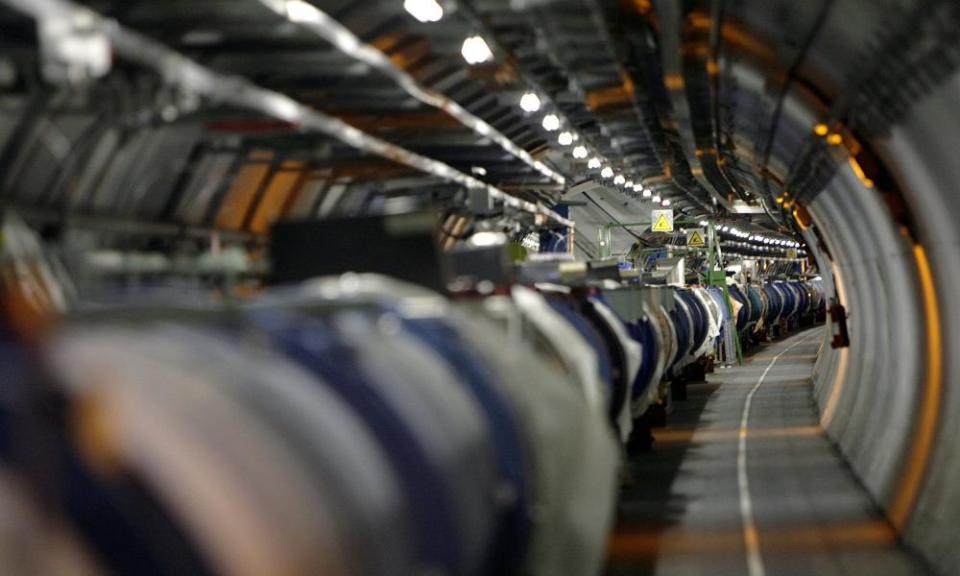£720m Large Hadron Collider upgrade 'could upend particle physics'

A massive project to supercharge the world’s largest particle collider launched on Friday in the hope that the beefed-up machine will reveal fresh insights into the nature of the universe.
The 950m Swiss franc (£720m) mission will see heavy equipment, new buildings, access shafts and service tunnels installed, constructed and excavated at the Large Hadron Collider (LHC) at Cern, the particle physics laboratory on the edge of Geneva.
The vast machine, which occupies a 27km circular tunnel under the French-Swiss border, hunts for signs of new physics by slamming subatomic particles together at close to the speed of light. In compliance with Einstein’s law E=mc2, some of the energy of impact is converted into new matter.
The upgrade will make the collider far more sensitive to subtle quirks in the laws of physics, and physicists hope these anomalies will prise open the door to entirely new theories of the universe.
In 2012 physicists on the LHC announced the discovery of the Higgs boson, which had leapt into the most fleeting existence inside the machine’s detectors when bunches of hydrogen nuclei, or protons, were crashed into one another billions of times over. The discovery earned a Nobel prize for Peter Higgs and the Belgian physicist François Englert for their theoretical work on the particle in the 1960s.
If the upgrade goes to plan, the proton beams in the souped-up accelerator, known as the high-luminosity LHC, or HL-LHC, will be so intense that the number of collisions in the machine will be five to 10 times greater than today.
“The high-luminosity LHC is where we will collect most of our data, and in that sense it is the phase of our exploration that lets us find out most about the universe,” said Tara Shears, a professor of physics at Liverpool University who works on the collider’s LHCb detector. “If the LHC so far has given us a candle to illuminate what was previously unseen, the high-luminosity LHC will let us shine a searchlight.”
Physicists are already exploring some strange signals at the LHC that could be the first hints that the so-called standard model of particle physics is about to break down. The standard model is a series of equations that describe how particles such as the electrons and quarks found inside atoms interact with each other. The theory works brilliantly, but physicists know it is incomplete: it says nothing about gravity, or the dark matter that clings unseen to galaxies, or the dark energy that drives the expansion of the universe, or why the world around us is made of matter instead antimatter.
The curious signals seen that the LHC in recent months are too tenuous to convince most physicists that they are real, but if they strengthen over time, as happened with the Higgs boson, they could reveal the existence of completely unexpected new particles, dubbed leptoquarks or Z primes.
To ramp up the number of collisions at the LHC, engineers will fit powerful magnets to squeeze the protons into finer, more dense beams. They then plan to fit devices called crab cavities that use an electromagnetic pulse to give bunches of protons a little sideways kick as they enter the LHC’s detectors. This makes the protons rotate a smidgen the moment before they strike protons coming the other way, which drives up the number of collisions. They are called crab cavities because they make the proton bunches move sideways, even if the rotation is minuscule.
“It’s a very exciting time,” said Rob Appleby, a particle physicist at Manchester University and UK spokesperson for HL-LHC. “It opens the door to the most precise and sensitive era of fundamental physics we’ve ever had.”
The upgrade is expected to take eight years. While new magnets and beam instruments will be installed when the LHC is switched off for two years in 2019, most of the required equipment will be fitted in a longer shutdown from 2024 to 2026, when the revamped machine will switch back on again.
“If the anomalies we see in the LHC at the moment manifest in the next couple of years, which they may well do, what we’ll be looking at with the high luminosity-LHC is the physics underlying those discoveries,” said Val Gibson, a professor of physics at Cambridge University who also works on the collider’s LHCb detector. “That would turn the standard model on its head. It would be totally groundbreaking.”

 Yahoo News
Yahoo News 